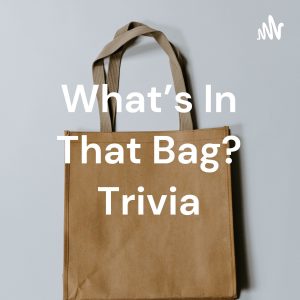What’s In That Bag? Trivia Podcast
Links to Podcast
https://open.spotify.com/show/5Qom95fh796Jwpjp3TG1LR
https://open.spotify.com/episode/4kjDKLMoBbdkkOSe9MrXwC?si=d889b0d338b54e8d
https://anchor.fm/daniel-macleod6/episodes/Episode-1-Whats-in-that-work-bag-e196oqn
Podcast Transcript
https://drive.google.com/file/d/1WmnONbd7YvJpnELCh-Bob-MY_8rJckid/view?usp=sharing
Reflection
This week was all about digital and multiple literacies and how the advancement in technology in the 20th century has expanded literacy and the ways in which humans communicate. Whether it is through print like text-messaging, audio like in podcasts, or visual like in multimedia etc., all of these text forms of literacy have expanded through the evolution of our linguistics, social environments, and cultures. One challenge that Dobson and Willinsky’s (2009) discussed is the “digital divide”, which suggests the division between who gets and who doesn’t get access to digital technology. In the 80s and 90s accessibility issues were likely caused by the high costs and low connectivity of these technologies but they were definitely a result of political and social problems too (Dobson & Willinsky, 2009). As costs have come down and connectivity has gone up, the digital divide has become narrower but even today there are still populations that are trying to catch up or left behind. Even when we do have access there is such an abundance of technologies that coincide with traditional print that makes it challenging for us to keep up with, especially for older generations of people who are not as familiar with how these technologies work. Mabrito and Medley (2008) discuss the challenges at colleges where professors have to change how they teach to meet the needs of today’s learners who have grown up using digital technologies. They discuss differentiating “digital natives” (Net Generation or Millennial students) from “digital immigrants” (Pre Net Generation professors) where the latter is having to learn all of these new forms of digital literacy just to keep up (Mabrito and Medley, 2008). Even being a millennial myself, with the continued evolution of digital technology I am finding myself getting more and more lumped into the “digital immigrant” category. With so much digital technology, it’s extremely difficult to keep up with and has even made this week’s task a bit challenging.
For this week’s task, I had to transform or “mode- bend” my submission for Task 1 – What’s in your bag? This was a challenging task, as I had to think hard about how I would change what I did for task #1 in a way that was in-line with what the New London Group discussed about needed changes in literacy pedagogy and their ideas about multiliteracies. So after thinking long and hard, I decided to do a podcast. Although I have listened to many podcasts before, for this task, I stepped out of my comfort zone as I have never created my own podcast before. I was willing to give it a try and luckily I was able to find a website that made it fairly easy.
For my podcast, I wanted to include more than just a verbal form of text as well as make it fun. So I decided to make it a trivia game and included different aspects of audio and visual like sound clips, music, and images to make it more engaging and entertaining. Using Task 1 as a reference I used bits and pieces while making some alterations to still represent the purpose of the task. To start I altered the name calling my podcast “What’s in that bag?” instead of “What’s in your bag?”. I then gave the title “What’s in that work bag? for the episode. I chose 10 items that were from my work bag in task 1 and then came up with descriptions/questions for each. In my podcast I gave an introduction and then asked the questions giving the listeners 10 seconds to guess before moving on to the next question. Some of the questions had audio hints as well. At the end I simply read the questions again and gave the answers just like a typical trivia game.
Using audio was a great alternative to the simple text that was used in task 1. I thought it allowed for a more engaging exercise but also another option for those who wouldn’t want to read written text. I really enjoyed this task but it was challenging to make the podcast flow in a way that was easy for the listener. I did a lot of editing to make the podcast work but I probably could have spent a lot more time trying to make it perfect. Even as I reflect on this now I am thinking about what I could have done or what I could have added to make the podcast better. Overall, I have gained a better understanding of multiliteracies and how our diverse cultures and changing social environments affect digital literacies. I even gained a better appreciation for podcasts as I once thought that they were simple but now realize that they take a lot of effort to make them well.
References
Dobson, T., & Willinsky, J. (2009). Digital Literacy. In D. Olson & N. Torrance (Eds.), The Cambridge Handbook of Literacy (Cambridge Handbooks in Psychology, pp. 286-312). Cambridge: Cambridge University Press.
Mabrito, M. & Medley, R. (2008). Why professor johnny can’t read: Understanding the net generation’s texts. Innovate: Journal of Online Education: Vol. 4:6, Article 2.
The New London Group. (1996). A pedagogy of multiliteracies: Designing social futures. (Links to an external site.) Harvard Educational Review 66(1), 60-92.
